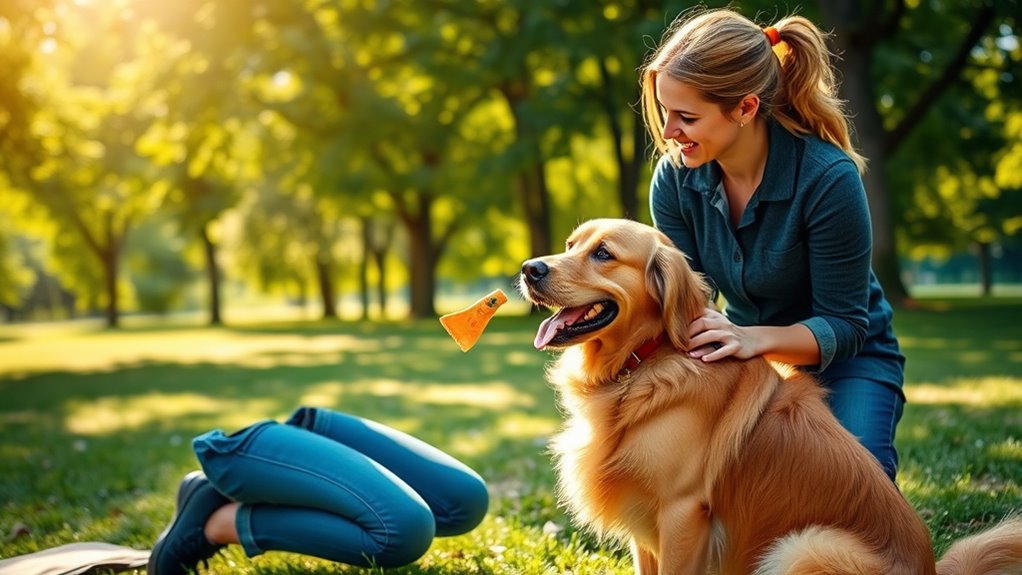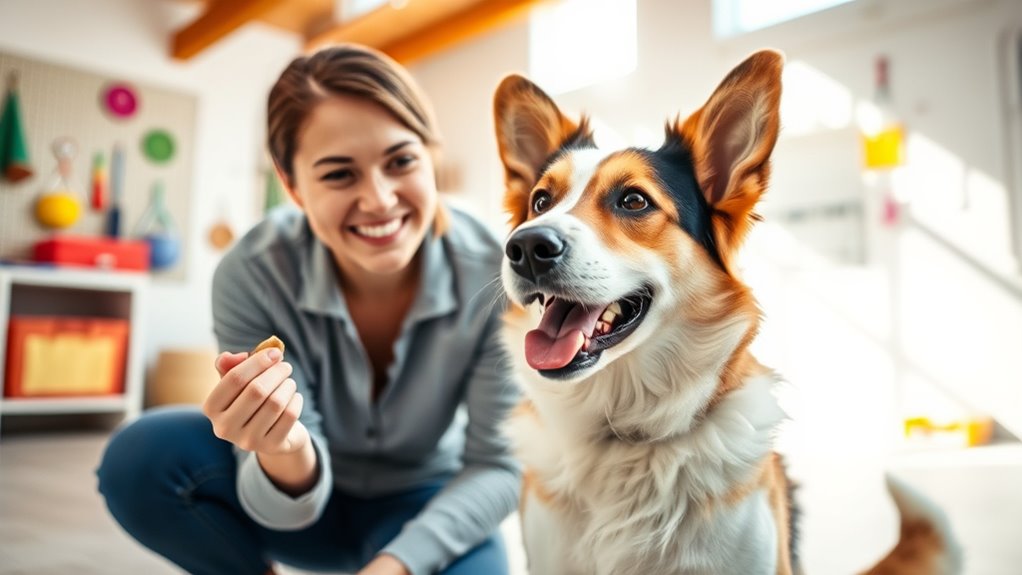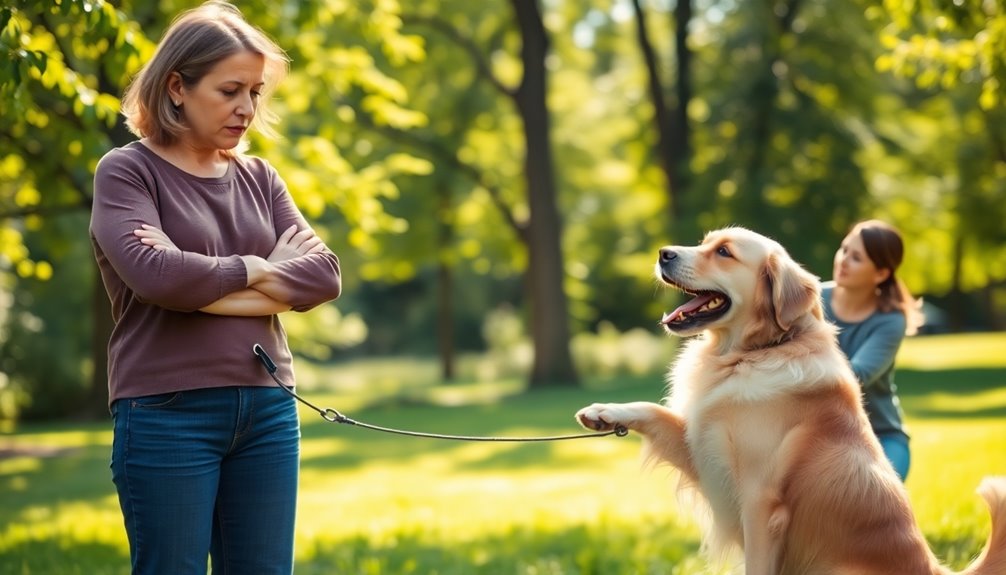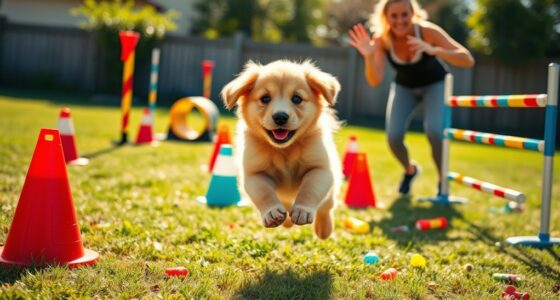Positive reinforcement training works best because it immediately rewards desired behaviors, making it easier for your animal to understand what you want. It builds trust, reduces stress, and encourages animals to repeat good actions. Using rewards like treats, praise, or play keeps animals motivated and engaged. Consistent, reward-based methods create a positive, clear, and effective learning environment. Keep exploring to discover how this approach can transform your training experiences with animals.
Key Takeaways
- Reward-based methods foster trust and strengthen the bond between trainer and animal.
- Immediate reinforcement helps animals quickly associate behaviors with positive outcomes.
- Breaking down behaviors into small steps reduces frustration and enhances learning efficiency.
- Positive reinforcement increases motivation and encourages animals to repeat desired actions.
- Creating a stress-free environment promotes better focus and long-term behavioral success.

Positive reinforcement training is a highly effective method for teaching animals new behaviors by rewarding desired actions. When you focus on rewarding good behavior, your animal is more likely to repeat it, making training sessions smoother and more enjoyable for both of you. One popular technique that exemplifies this approach is clicker training, which uses a small device that makes a distinct sound to mark the exact moment your animal performs the desired behavior. This precise timing helps your pet connect the sound with the action, speeding up learning considerably. Over time, the click becomes a reliable signal that they’re on the right track, which keeps motivation high and the training positive. Additionally, incorporating essential oils like lavender or peppermint during training sessions can promote relaxation and focus, enhancing the learning experience.
Behavior shaping is another key aspect of positive reinforcement training. Instead of expecting your animal to perform complex tasks immediately, you break down the behavior into smaller, manageable steps. You reward each small success, gradually guiding your pet toward the full behavior. For example, if you’re teaching your dog to roll over, you might start by rewarding them for lying down, then for turning their head, and eventually for completing the roll. This process keeps the animal engaged and confident because they’re consistently rewarded for their progress, no matter how small. It’s a gentle, effective way to teach complex behaviors without causing frustration or confusion.
Using rewards like treats, praise, or play, you reinforce the behavior you want to see. Consistency is essential—every time your animal performs the desired action, you immediately reward them. This instant feedback helps your pet understand exactly what they’re being rewarded for, strengthening the connection between the behavior and the positive outcome. Over time, your animal begins to associate the behavior with the reward, making it more likely to repeat it in different situations. The combination of clicker training and behavior shaping creates a clear, structured approach that’s both humane and highly effective.
Most importantly, positive reinforcement training fosters a trusting relationship between you and your animal. Instead of using punishment or intimidation, you focus on encouragement and rewards, which boosts your pet’s confidence and willingness to learn. This method also reduces stress and fear, creating a more positive learning environment. As your pet becomes more skilled, you’ll notice how quickly they adapt and how enthusiastic they are to please you. By consistently rewarding desired behaviors and shaping new ones patiently, you build a strong foundation of trust and communication that will serve you well in many training scenarios. Recognizing the role of essential oils in creating a calm atmosphere can further support a successful training process.
Frequently Asked Questions
How Quickly Can I See Results With Positive Reinforcement?
You can see results within a few days to a week, depending on your training frequency and reward consistency. The more often you train and the more reliably you reward good behavior, the faster your pet learns. Regular sessions keep your pet engaged and reinforce positive habits. Stay patient, be consistent, and celebrate small successes along the way to see steady progress in your training efforts.
Are There Any Risks or Downsides to Reward-Based Training?
You might worry about ethical concerns or reward dependence, but studies show only 10% of trainers report long-term issues. The main risks include over-relying on treats or creating frustration if rewards stop. To avoid this, balance training with praise and gradually reduce treats. This way, you guarantee your pet remains motivated without fostering dependence, keeping your training ethical, effective, and fun for both of you.
Can Positive Reinforcement Work With Aggressive or Fearful Animals?
Yes, positive reinforcement can work with aggressive or fearful animals, but you must approach behavior modification carefully. Use rewards to encourage calm, desired behaviors while avoiding triggers that escalate aggression. Always prioritize safety considerations, such as using barriers or protective gear, and proceed slowly. Patience and consistency are key, helping the animal build trust and reduce fear, ultimately leading to healthier, more positive behavior changes.
What Are Common Mistakes to Avoid During Reward-Based Training?
You don’t want to turn training into a comedy of errors, so avoid inconsistent timing and punishment avoidance. If you’re flaky with rewards, your pet will be confused, thinking, “Is this a game or a test?” Keep your timing precise, so your pet links the reward with the right behavior. Remember, punishing mistakes sabotages trust, so steer clear and focus on positive reinforcement for best results.
How Do I Choose the Best Rewards for My Pet?
You should choose treats your pet loves and can easily access during training, ensuring quick and effective reward delivery. Consider treat selection based on your pet’s preferences, size, and health needs. Timing is essential—give the reward immediately after the desired behavior to reinforce learning. Keep treats small and portable, so you can reward promptly and consistently, making training sessions more successful and enjoyable for both of you.
Conclusion
So, next time you’re tempted to shout or punish your pet, remember that positive reinforcement is the real superstar. It’s like giving a high-five instead of a slap—who wouldn’t prefer that? Rewards turn training into a fun, bonding game, while punishment just risks turning your furry friend into a grumpy roommate. So go ahead, reward those good behaviors; after all, it’s the easiest way to get them to love you—at least until dinner time.









